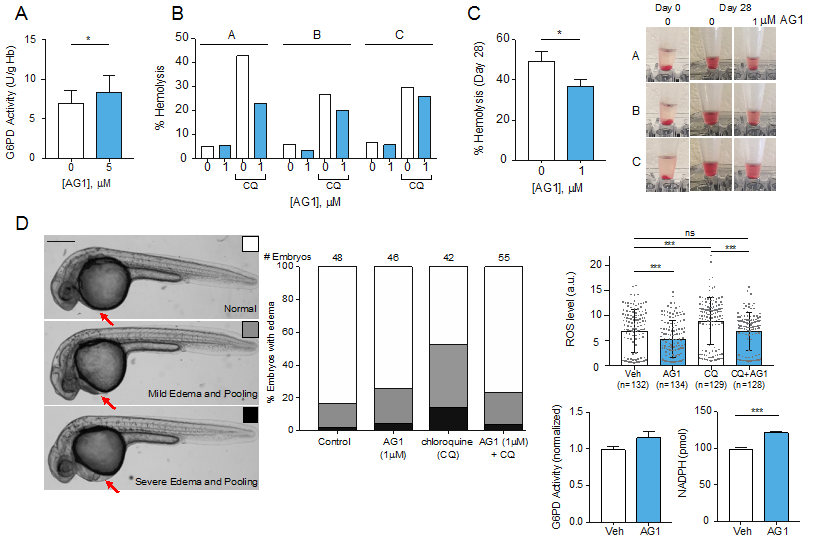To disclose G6PD enzyme activator (AG1) that can increase G6PD enzymatic activity. This molecule will be useful to treat G6PD deficiency.
Disease indication- G6PD (glucose-6-phosphate-dehydrogenase) deficiency, which can lead to hemolytic anemia, neonatal jaundice, bilirubin-induced neurological injury and bilirubin encephalopathy (kernicterus). Potential treatment for other oxidative stress related diseases.
Drug format- Small molecule.
Drug class- First-in-class, no current treatments or medications are available for G6PD deficiency.
- The inventors have identified a lead compound that activates many common G6PD variants up to 2-fold and increases their proteolytic stability. In vivo, this molecule reduced oxidative stress, increased NADPH levels and reduced pericardial edema in a G6PD-deficient zebrafish model. This molecule also reduced drug-induced hemolysis of human erythrocytes. The inventors are also developing and testing follow-on molecules in vitro and in vivo.
 Figure 1.(A) AG1 increased G6PD activity in hemolysates (n=15). (B) AG1 reduced hemolysis upon exposure to chloroquine (CQ=500μM) (n=3). (C) AG1 reduced hemolysis when erythrocytes stored at refrigerated temperature for 28 days (n=9). (D) AG1 reduces pericardial edema and pooling (indicated by red arrows) when embryos were exposed to chloroquine treatment (100μg/ml) and ROS levels with increased G6PD activity and NADPH levels.
Figure 1.(A) AG1 increased G6PD activity in hemolysates (n=15). (B) AG1 reduced hemolysis upon exposure to chloroquine (CQ=500μM) (n=3). (C) AG1 reduced hemolysis when erythrocytes stored at refrigerated temperature for 28 days (n=9). (D) AG1 reduces pericardial edema and pooling (indicated by red arrows) when embryos were exposed to chloroquine treatment (100μg/ml) and ROS levels with increased G6PD activity and NADPH levels.Target- G6PD enzyme.
Background- G6PD is critical enzyme for protection against oxidative damage in all tissues of the body. G6PD deficiency is the second most common human genetic disorder, caused by over 160 different point mutations in G6PD. These mutations lead to complete or partial loss of enzyme activity, leaving individuals with G6PD deficiency highly susceptible to hemolytic anemia, neonatal jaundice and kernicterus (bilirubin-induced brain damage). In particular, G6PD deficiency is known for hemolytic risk when affected individuals are exposed to oxidative stress triggered by certain foods, medications or infection.
Mode of action- The class of small molecules discovered by the inventors are allosteric chaperones of G6PD mutants. They activate common G6PD variants and increases their proteolytic stability. Experiments suggest that a single pharmacological agent may provide sufficient increase in function of several G6PD variants to alleviate the clinical problems associated with the enzyme deficiency.
Keywords- G6PD deficiency, hemolytic anemia, jaundice, kernicterus, neonatal hyperbilirubinemia, oxidative stress related diseases.
Competitive edge- First in class treatment for unmet medical need.

